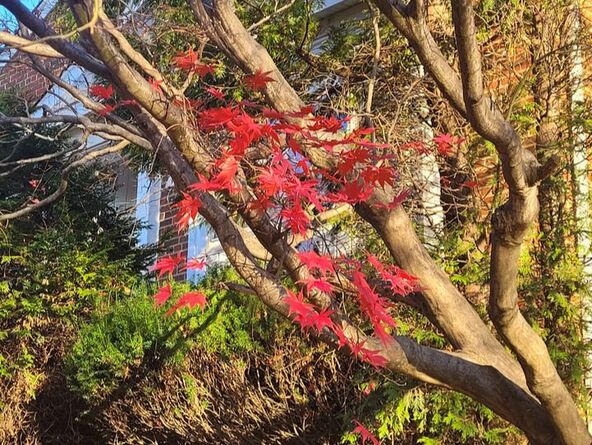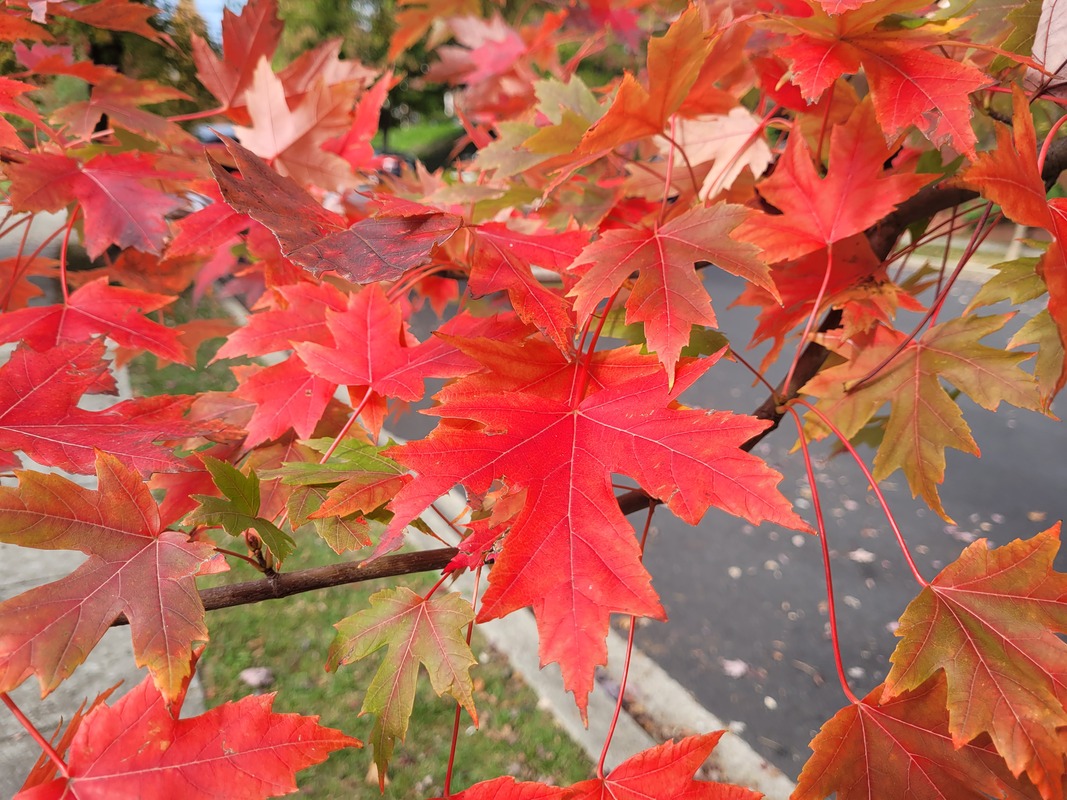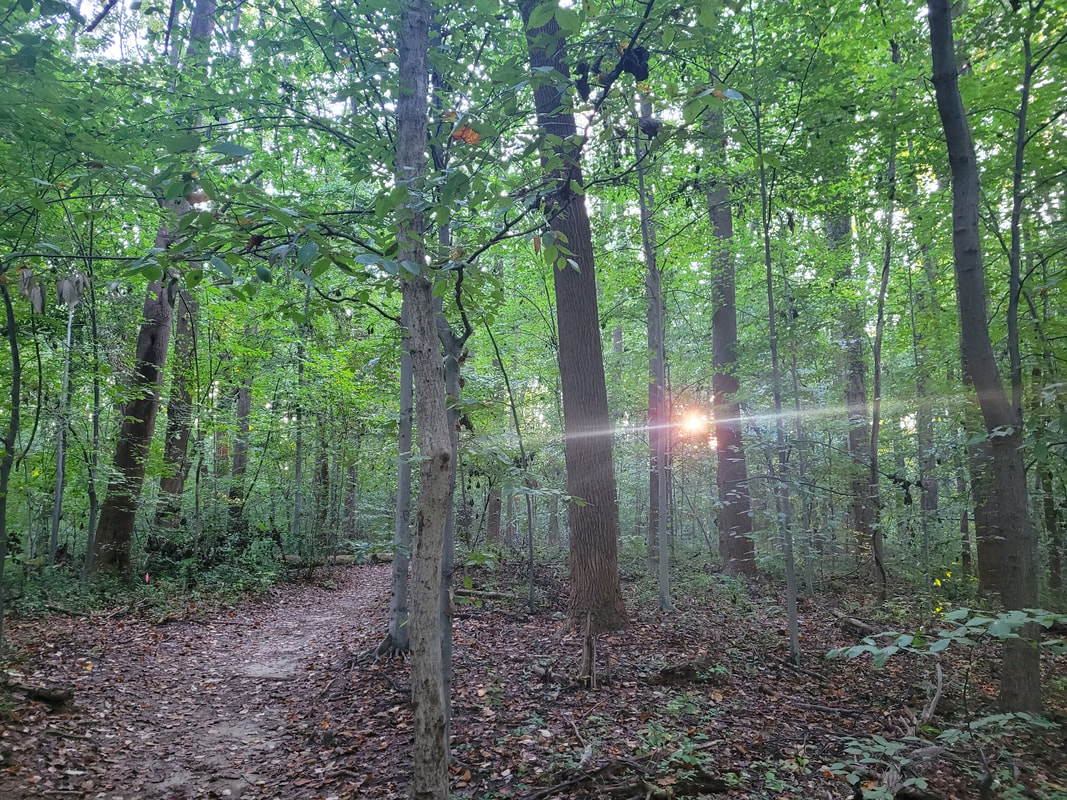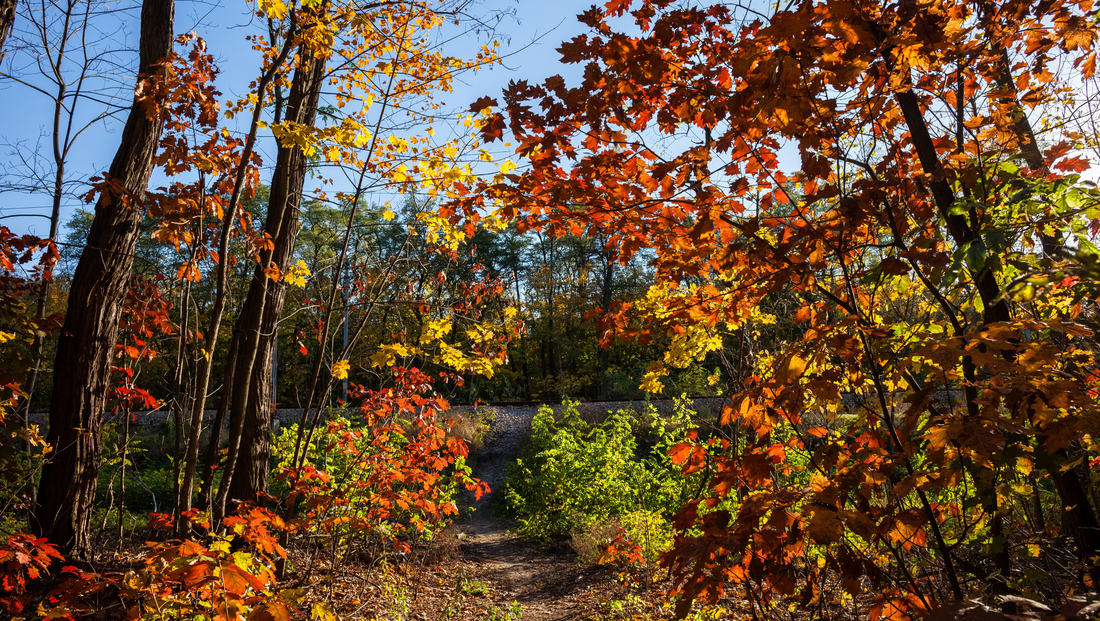|
The final leaves are falling here in Silver Spring. If you go out in nature or inside yourself, you can feel the world slip into the quiet envelope of winter. The mind might interpret it as lethargy or just "meh," but this feeling is often a gentle invitation into a sense of nothingness—an exquisite release from perpetual doing.
There's a beautiful opportunity to pause and reflect on our radiant being in this season of festivities, marked by celebrations of light amidst the year's darkest days. But sometimes the holidays’ busyness can overshadow the quiet sanctuary of rest. The question I like to ask is, “what's accessible now?” A nap, full night's sleep, or silent meditation may seem ideal but could be out of reach. Instead, listen for a fleeting moment of quiet, take a 2-minute break from the newsfeed, or just gaze at the wall. These moments too hold the potential for replenishment. Ever wondered about your nervous system during moments of rest? These pauses in our day where we balance out the rhythms of activity play a crucial role in keeping our nervous system within the window of tolerance. It's a gentle, loving gift we can offer ourselves, especially as we prepare for the winter ahead. Here's a simple practice suggestion: Imagine a robust refueling element of nature standing behind you (like a sturdy oak, big mountain, flowing waterfall, or a kind and loving Polar Bear). Let its soothing presence cradle you for a few breaths. Feel its strength infusing you with renewed vigor for a few more breaths. Return to this as needed. Equip yourself with DIY self-care tools useful for calibrating the energy of this season. Check out the kidney and urinary health workshop on December 16, as well as the Back Release and Chakra Balancing webinars at the Wellness Hub. May you find moments of rest throughout your day, leading to a restful way of being, Shira Oz-Sinai Acupressure, Family Constellations, Nervous System Regulation, and Shamanic Healing
0 Comments
The tree outside my balcony sparkles in the early morning autumn light. I take this in with a breath. A moment or two pass in awe, and I am changed forever.
Something is soothed. Something is opened up. Something is released. It's so small, so subtle... if I get distracted for a second, I'll miss it completely. The beauty of nature at times is heart breaking - whether it’s a sparkling leaf, a warm smile from a friend, or a kind gesture from a stranger. It breaks our heart open to love. To connection. To the light that pierces through. Yes, especially when everything feels so grim, and grief is overflowing. Awareness then may dawn that there's 'something greater out there,' and that we can simply take up our place with all others in the web of life. Practice Suggestion: From a spot inside your home beside a window, on your way to the car, or during a hike, take in the view and let yourself be inspired. Maybe it’s multicolored autumn leaves dancing in the wind. Or white clouds forming magnificent shapes in the blue sky. Take it in with a breath. It takes a nanosecond, requires no effort at all, and provides so much healing. May you let the beauty of nature mend your spirit, Shira Oz-Sinai Acupressure, Family Constellations, Nervous System Regulation, and Shamanic Healing P.S. Feeling the fog of grief? In need of connection and support? Don’t hesitate to reach out. Schedule a free complimentary call or check out the Wellness Hub for DIY self-care tools. As we journey from autumn into winter, the natural world whispers an invitation to lighten our load. Much like the trees gracefully shedding their leaves, we too are encouraged to release what no longer serves us. Old patterns, outdated beliefs, and stories that may have been based on misconceptions—these are the leaves of our past, now ready to fall. Autumn gifts us the opportunity to offer them an honorable ending and make space for fresh beginnings.
A season connected to the Metal element of the 5-Element Theory (think minerals, rocks, and gems), autumn invites us to conserve energy by simplifying our lives. Energetically related to the lungs and large intestine, it reminds us to breathe deeply and embrace life as it is while eliminating what no longer nourishes us. After all, we are not our attachments, grievances, or protective patterns. When we release and let go, we come to appreciate who we really are. Picture a metal pruning knife delicately removing small branches, leaves, or stems from a plant. In the same way, our letting go shapes and refines our healthy growth. Go ahead and cry it out, flush it down the toilet, breathe it out, and dust it off! You’re supporting a timeless alchemical process that reveals the luminous, crystal-clear, and loving presence that you are at your core. Practice Suggestion: Consider spending a few moments each day to simply be present with your breath. Notice the rise and fall, the ebb and flow. As you would watch autumn leaves drift gently to the ground, witness each breath as it moves. Change can be as natural as drawing in the next inhale. As you exhale, notice the release. This mindful breathing also reduces stress, improves focus, and promotes overall well-being. Want support for your journey of autumnal release and self-appreciation? Join me in this month's Immune and Lymph Booster: Acupressure Workshop, Intro to Family Constellation: Free Workshop, or private a one-on-one session. Additionally, you'll find a range of acupressure webinars to reinforce your autumnal self-care routines, such as the Respiratory Release and the Chest Release, at the Wellness Hub. May you release and come to appreciate the precious gem that you are, Shira Oz-Sinai Acupressure, Family Constellations, Nervous System Regulation, and Shamanic Healing Have you noticed the quality of light changing? The hues in the sky softly shifting, as if nature herself is preparing a canvas for the impending transition. As we welcome autumn, we step into a time of renewal, much like the students returning to their desks, with crisp notebooks and open minds.
One of the most compelling aspects of Chinese medicine is its profound awareness of change. It whispers to us that change is not our foe, but rather a dance partner in the ever-flowing river of existence. Can we make use of the wisdom gathered from ancient times about the flow of life? Can we embrace change with grace, not trying to transcend it but rather meeting it as it is? We look to the Earth element for support. As we bid farewell to the Late Summer season, where the Earth element prevails, we carry its nurturing essence with us into autumn. After we have harvested the fruits of our experiences, integrating the lessons learned, we are better prepared to let go of what no longer serves us. The unwavering stability of Earth anchors us, inviting us to ground ourselves, reconnect with our inner reserves and outer resources, and trust that we have within and around us the nourishment and care that will sustain us through the changes of the coming season. Let us take our cues from the element of Earth as we navigate the path of change and transition into autumn. We can find moments throughout the day to center ourselves, feel our feet, and connect with the solid ground beneath us. We can nurture ourselves with self-care that generates compassion and radiates out warmly like the sun’s rays, such as walks outdoors, a good meal with a close friend, self-applying or receiving acupressure, and reassuring self-talk that reinforces the message: “I’m ok. I’m not alone. I’m getting through this.” Now is the time to lovingly tend to ourselves as we navigate the transitions within and around us. As always, I am here to support you on your journey of personal growth and healing. Sessions continue as usual, available both virtually and in-person in Downtown Silver Spring. Reach out if you’d like to explore more. May the comfort of care for your self support you in navigating change, Shira Oz-Sinai Acupressure, Family Constellations, Nervous System Regulation, and Shamanic Healing P.S. As the autumn equinox draws near, I'm excited to invite you to the upcoming Autumn Meditative Card Night. Join me as we gather on this auspicious occasion to explore the beauty of the changing seasons, both within and without. Learn more below and register @ shiraozsinai.com/meditative-card-night. As we feel the touch of the late summer sun, we find ourselves immersed in the season of Earth in Chinese medicine's Five Element theory. Under this sun, the fruits come to ripen, and so do the opportunities for us to savor the sweetness of life's experiences and the wisdom they impart. This wondrous time invites us to digest the journey we've traversed, assimilating the challenges we've encountered and relishing the growth that came with them.
Life, like the seasons, offers a beautiful dance of cycles. We move through various experiences, some delightful, others arduous. Yet, as we navigate these moments, we are offered the gift of learning and transformation. The trials we overcome are not simply obstacles; they are stepping stones on the path to our personal evolution. As a fruit matures, it undergoes a transformative process. The ripened fruit carries the essence of its journey within, just as we too hold the wisdom of our experiences inside. Once we've weathered the storm, we have a chance to savor the juiciness of the lesson, embracing the growth it has brought. It's the moment we can voice, "The hard parts are over now" and "I have grown from it." In Late Summer's embrace, we receive the message that we are resilient beings, capable of turning our challenges into opportunities for growth. We come to understand that these experiences are not meant to break us; they are here to shape us into wiser, more compassionate versions of ourselves. Let us celebrate this season by taking time to savor the sweetness of our breakthroughs and recognize the strength we've gained through life's trials, allowing it all to nourish our souls.
On the topic of digestion, join me this month for the Acupressure for Self-Care Workshop, where we'll explore simple yet effective techniques to improve digestion, ease constipation, soothe diarrhea, and alleviate discomfort from hemorrhoids. Secure your spot today to explore the profound wisdom of your body and nurture your well-being from within. As always, I am here to support you on your journey of personal growth and healing. If you'd like to book a one-on-one session or have any questions, feel free to reach out. May we continue to savor life's sweetness and embrace the nourishment it brings. Shira Oz-Sinai Acupressure, Family Constellations, Nervous System Regulation, and Shamanic Healing P.S. The late summer sun and changing temps are already hinting at autumn. Mark your calendars or sign up now for the upcoming Autumn Meditative Card Night on Saturday, September 23, at 10 am ET via Zoom. Welcome the seasonal transition through reflection, meditation, and oracle card readings to nourish your soul. Save your spot here. As we embrace the vibrant energy of summer, let us explore a pathway to increased pleasure, joy, and calm by focusing on the ventral vagal capacity within our nervous system. The ventral vagal state, also known as the social engagement system, is a crucial aspect of our well-being and plays a significant role in our ability to connect with others, experience inner peace, and find genuine happiness.
When the ventral vagal state is interrupted, our nervous system can shift into two states: sympathetic activation and dorsal shutdown. Sympathetic activation is associated with the "fight-or-flight" response, involving heightened stress, anxiety, and a sense of urgency. On the other hand, dorsal shutdown is associated with the “freeze” response, involving disconnection and feelings of numbness, depression, and isolation. Consider a scenario where you're having a heartfelt conversation with a close friend, sharing vulnerable emotions. Suddenly, your friend responds with a dismissive remark or doesn't seem present in the moment. This interruption to the ventral vagal state of connection can trigger a shift in your nervous system. You may feel a surge of frustration, defensiveness, or sadness, disrupting the safe and harmonious connection you were experiencing. Instances like these illustrate the profound impact interruptions can have on our ventral vagal state of connection. One of the key insights I have gained from the Polyvagal Theory, particularly through the work of Deb Dana, is that regulating our nervous system's sympathetic activation and dorsal shutdown is not the sole solution. Equally important is the active endeavor to expand our capacity to stay connected, even when faced with a challenge. Intentionally expanding our ventral vagal capacity paves the way for nurturing deeper relationships, cultivating authentic connections, effectively resolving conflicts through clear communication, and establishing a strong foundation of safety and trust. Embrace this summer as an opportunity to harness the energy of expansion and heartfelt connection already present in nature all around us and within us. By consciously engaging in practices that stretch our ventral vagal capacity, such as deep breathing, mindful movement, positive social interactions, and self-compassion, we gradually restore and expand our innate ability not only to connect deeply but also to experience pleasure, joy, and calm. May your summer be filled with boundless pleasure, radiant joy, and a profound sense of calm within. Shira Oz-Sinai Acupressure, Family Constellations, Nervous System Regulation, and Shamanic Healing P.S. Ready to unlock new levels of pleasure, joy, and calm? Schedule a call with me to discover practical strategies and personalized insights tailored to enhance your capacity for a more vibrant and connected life. Whenever I spot swallows gracefully soaring through the skies, I feel the unmistakable arrival of summer in Maryland. According to legend, a brave Barn Swallow daringly stole fire from the sun to bring to earth. This act of audacity incurred the wrath of a god who hurled a firebrand at it, singeing its tail feathers and giving it its distinctive forked tail. Between the legend, the joyful and amicable spirit of these winged beings, and their meditative presence, swallows reveal profound insights that empower us to harness the abundant fire energy of this season.
Swallows exhibit mesmerizing aerial acrobatics. With effortless fluidity, they seem to dance in the air, engaging in a magnificent display of playfulness and freedom. Their skillful circling invites us to discover our own distinctive paths to joy, even amidst life's challenges. We may dance our own little circle, cherish laughter, or savor life's simple pleasures. By embracing joy, we nourish our hearts, uplift our spirits, and create a harmonious balance within ourselves and the world around us. Listening to the sweet chatter of swallows, we witness their innate ability to connect and communicate, serving as a gentle reminder of our own capacity for authentic dialogue. As summer envelops us, we are inspired to engage in conversations that foster understanding, empathy, and harmony. Through dialogues with parts of ourselves, nature, or others, guided by our wise and discerning hearts, our connections grow secure, nurturing a profound sense of love and belonging. Swallows often pause on eaves and wires, observing the world around them. In their stillness, it's as if they listen to the whispers of their strong hearts and embrace the fullness of life. Just as swallows find tranquility amidst the bustling activity, we too can uncover moments of peace amid the vibrancy of the season and the busyness of our lives. It is in these moments that we reflect on our own journey, nourish our souls, and open ourselves to growth, expansion, and new possibilities. This month, I want to continue to shine a light on the Wood element in Five-Element Chinese Medicine - this time focusing on its ability to support clear and healthy boundaries.
The Wood element corresponds to the liver and gallbladder meridians in our body. Its deficiency can lead to indecisiveness or lack of direction, while excess Wood energy can cause frustration or rigidity. When balanced, the Wood element helps establish clear boundaries, enabling us to differentiate between what’s ours and what’s others. This clarity allows us to harness our life force energy and fulfill our potential. Imagine a tree growing in a forest, sending its roots deep into the ground and stretching its branches towards the sky. It doesn't compare itself to others or try to be something it's not. Instead, it simply focuses on being the best version of itself it can be, and in doing so, it becomes a vital part of the forest ecosystem. Similarly, when we cultivate our Wood energy, we become more attuned to our unique gifts and strengths, showing up authentically and contributing to the greater good. I recently worked with a client, let's call her Emily, who struggled with people-pleasing and saying yes to things she didn't actually want to do. As she worked with me to cultivate her Wood energy, Emily gained insight into her needs and desires. As a result, she confidently declined a work project that would have disrupted her self-care routine, instead prioritizing time to nurture important friendships. This shift helped Emily reaffirm healthy boundaries and move forward with a greater sense of purpose and joy. By cultivating your Wood energy, you too can experience greater clarity and focus in your life. As the flowers start to bloom and the days grow longer, we feel the energy of spring pulling us into action. This season, we are inspired by the Wood element in Chinese medicine, which embodies the strength and resilience of trees.
Just as the roots of a tree grow deep into the Earth, so too do we have the potential to dig deep and find strength within ourselves. The Wood element is all about this potential for growth, helping us harness the strength to make moves that bring our dreams into fruition. What kind of world do you dream of? As we celebrate Earth Day on April 22nd, we are given the opportunity not only to imagine the world we wish to live in but also to feel into our interconnectedness with all living beings and the impact of our actions. This month, let us embrace the energy of spring and the Wood element, anchoring ourselves in the present while stretching towards the future. Let us take action to live out our fullest potential in honor of our past, where we come from, and our place in the family of all living beings As we move from darkness to light, from winter to spring, there are often no words. They haven't formed yet. There's just pure sensation. Raw energy. Unnamed. Gray.
It can be uncomfortable. Really uncomfortable. Much is unknown. The winds pick up and shake loose what isn't pinned down. Debris of the old. All that isn't grounded in the here and now is swept away. Who will I be if I'm not what I was? The mind attempts to regain control, to hold steady in a storm of change. But if we stiffen against the winds, we will likely break. The Wise Heart offers a gentle "Yes!" to this question. Yes to discovery. To a new adventure. To growing. To branching out. To life! If we soften, relax into what is, we may sway side to side but remain standing. Then new blossoms will burst forth, and our world will fill up with bright colors once again. |
SHIRA OZ-SINAII am an acupressurist, educator, and practitioner of complementary medicine. My background in literature, teaching, and Yoga Nidra informs my wellness practice. My approach is personalized and holistic, tailored to each individual's unique needs and goals. Archives
December 2023
Categories |










 RSS Feed
RSS Feed